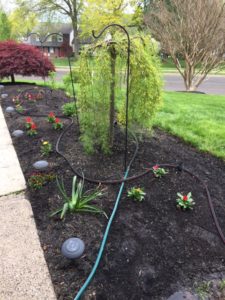I’m not a gardener. I wish I had enough funds to have a landscape team plan, plant and maintain a variety of gardens on my property year-round. Alas, that’s not the case. My “garden” is comprised of plants, flowers and shrubs planted haphazardly throughout the years. Some are dependable and present me with a gorgeous display of color and fragrance each season (thank you, peonies); others are so unpredictable, I am always surprised when they spring from the ground in a show of color. (I’m talking to you, tulips.) See? Gardening is neither my forte nor my passion. But, recently, my husband and I planted a garden that is guaranteed to attract hummingbirds and butterflies. It’s right outside my front door, just beyond my covered patio, where I can sit in the shade and watch (and photograph) what I hope will be a very active display of nature at its finest. While I don’t enjoy gardening, I can think of few things I like more than being outdoors, barefoot in the grass, surrounded by the beauty, color and fragrance of flowers. The world seems to disappear, even when I’m doing nothing more than sipping tea on my deck and watching the birds fly by.

While you may enjoy being outside, you may not know that getting outside is also good for your health. The Outdoor Power Equipment Institute (OPEI) – yes there is such a group and their website Is awesome. Wish I’d known about it before I planted my hummingbird garden. – outlines five health benefits of getting outside. And, of course, I’ve got them for you:
Benefit #1: Your lawn can make you happier! Our stress levels fall within minutes of seeing green spaces. Knowing and experiencing nature makes us generally happier, healthier people.
Benefit #2: Getting dirty is good for you! Mycobacterium vaccae in soil mirrors the effect on neurons that Prozac provides. Give your kids a pair of gardening gloves and have them work with you in your green spaces for a hefty dose of Vitamin N(ature) and G(reen). People who spend time gardening and have direct contact with soil feel more relaxed and happier. (I hope that’s true for people like me who like to sit in gardens!)
Benefit #3: Exposure to natural settings may be widely effective in reducing attention deficit/hyperactivity disorder (ADHD) symptoms in children. Children gain attention and working memory benefits when they are exposed to greenery.

Benefit #4: Living landscapes help people and pets be healthier. Playing outdoors increases fitness levels and builds healthy, active bodies. Research also shows that children reap numerous health, social and personal benefits from spending time outside playing.
Benefit #5: Your lawn produces lots of oxygen and cleans the air too. Fifty square feet of grass generates enough oxygen each day for a family of four, and reduces the “code red” effect since grass removes pollutants from the air we breathe.

“Our living landscapes not only provide beauty, but are a stress-reliever, a recreational space, a wildlife habitat, and an outdoor living area,” said Kris Kiser, president and CEO, OPEI. “Studies show that our green spaces contribute to our health, happiness and intellect.”
For more information on how to create a living landscape and some absolutely gorgeous photos, visit http://www.livinglandscapesmatter.com.
YOU MAY ALSO LIKE:
On Mother’s Day and Every Day …
Don’t Forget to Apply Sunscreen to These Often Overlooked Places …
The Fashion Trend That’s HUGE This Spring